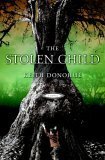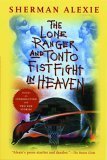Book Review: "The Stolen Child" by Keith Donohue

The Stolen Child is one of those books that's hard to categorize. While it's a coming of age story it has a bit of a twist. The twist being the mixing of the mythos of faeries,hobgoblins and changelings. Keith Donohue got the inspiration for this book from the Poem of the same name by William Butler Yeats, in which a child is lured away from home and into the woods by a changeling.
In Donohue's book he asks the question, "What happens next?" "The Stolen Child" is about a young boy named Henry Day who runs away from home and is taken by the changelings. Now the myth of the changelings is that a changeling takes the place of the young child abducted and in this case Henry Day is replaced by a changeling and Henry becomes a changeling.
That is just where the story begins. The rest of the book follows both versions of Henry Day (the changeling/hobgoblin version changes his name to Aniday). The "now human" version grows up to be a piano virtuoso, because of a past he had before becoming a changeling. The changeling version learns to accept his life as a changeling but always wondering what his life would have been and missing his family. While the "now human" version is constantly seeking information on his past life.
Both versions fall in love and seek their pasts while one loses his love the human form gets married and has a son and worries about the son being taken by changelings. The soul searching through this book never seeks an apology for what has been done but rather, an acceptance and moving on of lives.
It was purely concidental that I read this book around halloween, but while reading I did keep an eye on my son and one over my shoulder. This book is beautifully written, poignant at times and with some humor thrown in. A very good read that could easily become a classic.

posted by Gil T. @ 9:32 PM


Book Review: THE MISERABLE MILL. A Series of Unfortunate Events BOOK the fourth by LEMONY SNICKET

Once again we join Violet, Klaus, and Sunny Baudelaire, otherwise known as the Baudelaire orphans and heirs to the Baudelaire fortune. But this book is a little different from the other three, at least 2 of the 3. In 2 of the last 3 books the orphans started out with some family member (usually very distant family) and a nice home, somewhat. Well in this book the orphans are dropped off at a train station at Paltryville and told to find their new caretaker, the owner of Lucky Smells Lumber Mill. Upon arrival at said mill they are told they will work at the mill (even though they are only children) and in return their new caretaker, Sir, will not allow Count Olaf to get to them.
Their new custodian, Sir, by the way, is called Sir because "No one could pronounce the name anyway." Also his head is in a constant haze of cigar smoke so you never see his face. He pays his employees in coupons, such as buy one snow shovel get one free and is constantly reminding everyone (including his partner) that he is "The Boss" because that's what the plaque says on his desk.
This book to me seemed to be difficult to get through, and I think that is due to the fact that we don't hear from Count Olaf or his minions until 3/4 of the way through the book. At least we don't think we hear from him. But as any Lemony Snicket reader will know, he is lurking in the background.
The continued sarcasm and wit of the Author, Lemony Snicket, is even more prevalent in this book. Especially once the orphans find out where Count Olaf is hiding. At this point it becomes a serious page turner with some wonderful comic relief. Once again, though, there is no happy ending just a continued, and maybe even more so, series of unfortunate events.
posted by Gil T. @ 2:40 PM


Book Review: The Lone Ranger and Tonto Fistfight in Heaven by Sherman Alexie

When I sat down to write out this review, the only thing I could say was "Wow!" Sherman Alexie first of all has a great style and can captivate you with his words alone. I would love to sit and talk with him for about 100 years. Then take another 100 years to sit back and absorb it all in. Not only does he have the great command of language but he also has a great insight into telling the stories from "the Rez." I read the updated version of the book published in 2005. This version has an intro by the author and 2 bonus stories. The original was published in 1993.
I was attracted to the book after watching the movie "Smoke Signals" which is based on the stories in this book. I was so pleased to find the stories that reminded me of the movie but even more so to find extra. Not only are these stories of life of Indians, for the politically correct, Native or Indigenous Americans, but they are also little lessons anyone can relate to. Also there are more than just stories there are "non-rhyming" narrative poems. Mr. Alexie draws great pictures with these.
Every story or poem will make you laugh a little and make you cry a little each time. I have chosen a couple of quotes from the book that will help illustrate what I mean by the lessons and realism.
"Winning all those contests makes you about as famous as the world's best xylophone player"
"I want to rasp into sober cryptology and say something dynamic but tonight is my laundry night. How do we imagine a new life when a pocketful of quarters weighs our possibilities down?"
I also picked out these quotes to "tease" you with some intrigue as to what may be in these stories.
This book tells tales of the hoplessness and the hopefulness of the poor and unfortunate, especially those that live on the reservations. Mr. Alexie has been criticized as pushing the stereotype of the "drunken Indian." But in the introduction he says if the truth is a stereotype then I can only tell truth. He also mentions how some of the stories may have some autobiographical nature to them.
If you are looking for a book that will run the emotional gamut (usually with one paragraph) then make it a point to read this book. There is not a bad story in this book.
I was hoping to write a review that would eventually get around to Mr. Alexie and he would be so inspired that he would contact me and we could hang out. But I'm afraid that all I can still say is "Wow!" This book left me emotionally tired, but definitely with a satisfied feeling. I'm going to get some emotional rest now.
posted by Gil T. @ 7:44 PM


Book Review: "The Wide Window (A Series of Unfortunate Events, Book 3)" by Lemony Snicket

I'm continuing in my quest to read all 13 books in this delightful series. (Okay, I mean delightful in the sense that it makes for some entertaining reading, by no means do I mean that the poor Baudelaire orphans have delightful adventures.) Mr. Lemony Snicket (a.k.a. Daniel Handler) has just released book 13 "The End." From my recent interest in the books I'm saddened that I didn't start reading them earlier. But then again, I can now read all 13 without interruption.
The books were originally purchased for my kids and when I saw that they were as engrossed in them as they were with the Harry Potter books, I had to try them...about 6 years too late.
In this contribution to the series we find the Baudelaire orphans being sent to their Aunt Josephine, okay once again not a direct relative but their second cousin's sister-in-law, but the closest to family they have. Aunt Josephine is a great character, she's afraid of everything, including realtor's, and is a perfectionist when it comes to grammar. She has a whole library full of grammar rule books and in that same library is the "wide window" looking out on Lake Lachrymose.
Once again Count Olaf returns to take the Baudelaire fortune, this time under the guise of Captain Sham, whose business card proclaims him to be proprietor of Captain Sham's Sailboat Rentals. He flirts with Aunt Josephine enough to get through her shell and later convinces her to commit suicide and leave the children to him. Now as you may remember Count Olaf has already tried different ways to get the fortune, one by adopting them, one by trying to marry Violet (the oldest) and then by murdering Uncle Monty and threatening to take the kids to Peru.
Once again, Lemony Snicket does not allow the reader a happy ending. It always ends bad for the orphans, but the creativity in the writing and the fun characters make this book a great read. And like I say any book that gets "kids" of all ages reading it's worth checking into.
This book cemented my fandom. I was on the fence before but now, I'm a Lemony Snicket Fan.
posted by Gil T. @ 9:04 PM


I will never again go to Mexico...Okay so I only went to Tijuana before, but now...

Book review: "The Ruins" by Scott Smith
I have just read one of the creepiest, scariest books since Stephen King's "The Cell," "The Ruins" by Scott Smith.
Let's start off by talking about who the author is. Scott Smith is the author of the 1993 book "A Simple Plan." And he also wrote the screenplay, which got him an Oscar Nomination. Remember that book or movie? The downfall of some folks that found lots of money? Well, after 13 years Mr. Smith has written another book that traces a different sort of downfall. This book is written balls to the wall. There aren't even any chapter breaks. Once the action starts, it is a struggle to put the book down or even to find a place to put the book down.
4 Americans (Jeff, Amy, Eric and Stacey) are on vacation in Mexico. Where they meet up with a German who speaks English (Matthias) and 3 Greeks who speak neither English nor German, but have prided themselves on adopting "Mexican" names, Pablo, Juan and Don Quixote. Matthias' brother Heinrich has taken off with a girl who is an archaelogist working on the site of some ruins. After some time Matthias worries about Heinrich and goes out to find his brother armed only with a note and a map sketched on a napkin. The Americans and One Greek, Pablo, decide to go along, after all what is Mexico without some Mayan Ruins?
The horror begins when they discover a Mayan Village and realize they must have missed the path as sketched on the map. The villagers try to ignore the party of 6 tourists but when the tourists venture onto a path that the villagers have been trying to conceal, the Mayans must become aggressive. First they try to warn the party from going onto a hill that has been overgrown with a vine with beautiful stained glass red flowers. But as soon as one steps into the vine the Mayans draw their bows and force the party to the top of the hill. All around the hill the tourists notice small mounds when they approach one of the mounds they discover the skeletal remains of Heinrich. The Mayans keep guard and do not allow the tourists off the hill under threat of death. But the tourists soon discover that death by arrow would be better than what the ruins and the vine have in store for them. The red color of the flowers is soon replaced by the constant flow of red blood.
Scott Smith, writes the book in what seems like one breath...at least I don't remember exhaling. The approach he uses is the never-turn-away-method. Once the action and gore start the author forces the reader to look closer. Such as when Pablo falls down a mine shaft and breaks his spine. We go through the process of having to lift his useless legs onto a makeshift backboard and then having to amputate his legs after they have been stripped to the bone. Or when Eric gets a glass cut after trying to help Pablo out of the mine shaft and then to discover the vine growing inside him the next morning the vines use the cut as entrance, then using a knife to carve up his own body to rid it of the vine...out of paranoia? You decide.
If you like horror, suspense, thrillers this is your book. If you are looking for a Zagat's guide to Mexico....Stay away from this book.
posted by Gil T. @ 3:09 AM


How to re-evaluate the world and your position in it.

a Book Review: "Animal Liberation" by Peter Singer
At the risk of losing many of you at the first part of this review, I will tell you this book was recommended by PETA. I have recently had my stomach and life turned by a few books about the meat processing system, and was eager to find more information. Those books were "The Jungle" by Upton Sinclair (See previous review), "Don't Eat This Book" by Morgan Spurlock, and "Fast Food Nation" by Eric Schlosser. At first I thought it would only be fast food that I'd be turned away from. But then I realized the meat packing plants don't care if they are slaughtering for home use or fast food use, all the same abuses happen.
In "Animal Liberation," Peter Singer takes us on a journey of the mind, ethics and morality. The book is broken down into 6 chapters, each independent of each other yet building on one another, so I will break this review down to a chapter by chapter review/summary.
Chapter 1. All Animals are equal...or why the ethical principle on which human equality rests requires us to extend equal consideration to animals too.
In this chapter the author presents the idea of "speciesism." This is along the lines of racism, sexism, etc. This argument is presented with simple, straightforward facts and ideas with no emotion tied to them. In fact throughout the book the author does not attempt to influence the readers way of thinking only to spur (pun intended) the thinking process. On the idea of human equality, The principle of equality is not a description of an alleged actual equality among humans: it is a prescription of how we SHOULD treat human beings. This equality should and could be carried over to "non-human" animals. Why should animals be forced to live in conditions we would not allow the lowliest of humans live in? Why should we as humans claim the right to slaughter and eat animals. Why should we as humans think that animals are there for us to pour chemicals on just to see how they react, or "condition" through painful electric shock? The author answers these questions, by saying simply. We shouldn't.
Chapter 2. Tools For Research...your taxes at work.
This chapter is one of the 2 extremely disturbing chapters which the squeamish should not only read but ask why we do these things. Or better yet allow these things to happen. I'm talking about using animals for cruel research projects. From shocking monkeys to learn how to fly a plane and then inducing radiation sickness on them to see if they can still fly with little electric shock "reminders" to pouring chemicals into bunnies eyes that we already know are irritants. In this chapter a European scientist after viewing several psychological animal experiments is quoted as calling American Scientists barbarians. The ironic part is that really, European scientists are cruel...just not as cruel as Americans. One quote that I love is that in experiments still going on now to find how much smoking contributes to lung cancer the author asks, "If people continue to smoke, knowing that by doing so they risk lung cancer, is it right to make animals suffer the cost of this decision?" The final outcome of this chapter is that animal research is completely unnecessary. For example, in guinea pigs pennicillin causes adverse effects, if we had accepted this animal research we would never had the use of that extremely useful medicine for humans.
Chapter 3. Down on the Factory Farm...or what happened to your dinner when it was still an animal.
One of the cruelest things discussed in this book is the treatment of veal cattle. These young calves are taken from their mothers (usually machine siphoned dairy cows) and kept in cages/pens which they cannot move because if they did move...the meat would not have that tender veal quality. They are also kept from having the proper nutrients because the nutrients would darken the meat. All for some snobby rich person to have their unique meat. That is just useless waste. The atrocities to other animals are also discussed. (For more on this go to my myspace site and watch the "Meet Your Meat" Video. http://www.myspace.com/gilwilson)
Chapter 4. Becoming a vegetarian...or how to produce less suffering and more food at a reduced cost to the environment.
Finally someone not only tells you why but how. And really it is just as easy as saying...leave off the meat. The main idea behind becoming a vegetarian is that in becoming a vegetarian a person would increase the amount of grain available to feed people elsewhere, reduce pollution, save water and energy, and cease contributing to the clearing of forests; moreover, since a vegetarian diet is cheaper than one based on meat dishes, they would have more money available to devote to famine relief, population control, or whatever social or political cause they thought most urgent. That's it in a nutshell. Now, keep in mind I'm not a full fledged vegetarian, but I'm working on it. I was back in college and never felt better.
Chapter 5. Man's Dominion... a history of Speciesism.
Here we go off on a tangent of how throughout times (from biblical to modern) we have denied the "non-human" animal freedom. I found this chapter to be dull but informative. It shows how throughout times humans have been cruel...but in an optimistic turn shows how views have slowly changed.
And Finally
Chapter 6. Speciesism today
Basically this shows the progress we are making...and have made in the be nice to animals campaign. Really folks it isn't hard stuff here. Why should we hunt animals for mere trophies? Why should we wear fur when synthetics are just as easily available and look just as nice?
Well what do you think?
posted by Gil T. @ 10:54 PM






































